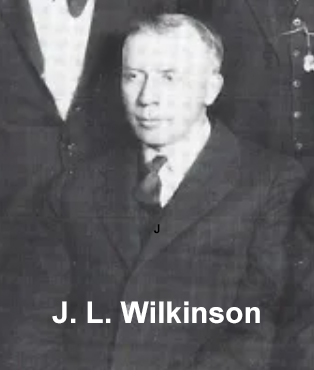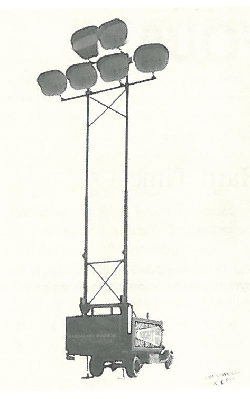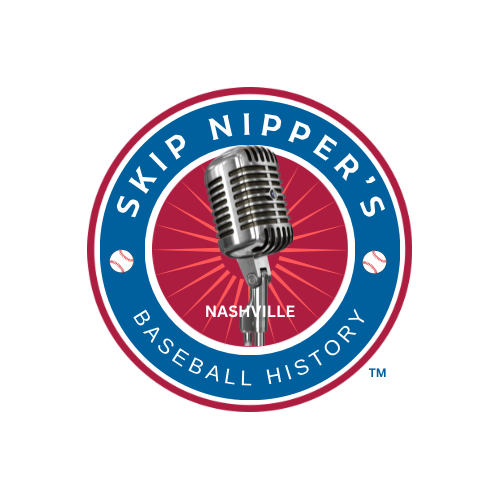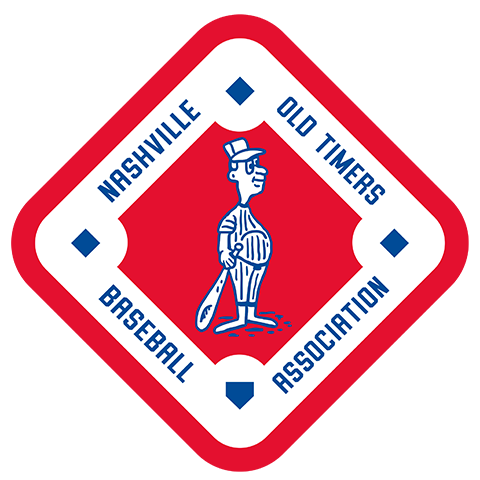
J. L. Wilkinson’s Kansas City Monarchs won the Negro National League pennant in 1929, and when the Stock Market crashed on October 24, it did not bode well for his team. The league had just had the lowest gate receipts in the league’s history.[1]
Lighting System for Night Baseball
The white team owner considered abandoning the league and making his club a touring independent team. But a radical idea was soon born, as he devised a plan not only to allow players to play night games but perhaps to pique the interest of fans so they would come to his team’s games out of curiosity.
He purchased a lighting system portable enough that he could take it to ballparks across the country.
Wilkinson took on Thomas Baird as a partner and mortgaged nearly every asset he had to fund the venture. Giant Manufacturing Company in Omaha, Nebraska, constructed the towers, floodlights, and generator at a cost of between $50,000-$100,000.[2] The telescoping poles had five or six lights, and when fully extended were only 50 feet high. The generator used 15 gallons of gasoline an hour[3] and was very noisy.
Before the Monarchs began their travel schedule, the touring House of David team rented the lights.[4]The Monarchs’ first night game took place in Enid, Oklahoma, where they played Phillips University on April 28, 1930.[5] The Monarchs introduced the system in games all across the south. Wilkinson even rented the lights to Shreveport in the first night game in the history of the Cotton States leagues.[6]
Lights at Tom Wilson Park
Nashville’s Wilson Park, located at the end of Second Ave., south near the Nashville & St. Louis railway track, was one of the earliest ballparks for the unique lighting to be used. The home ballpark of Tom Wilson’s Nashville Elite Giants, Wilkinson’s Monarchs played a two-game series on May 14 and 15.
The Nashville Tennessean article announced the event on May 13.
“The baseball fans of Nashville as well as the idly curious will have a chance to see what night baseball is like when Nashville Elite Giants meets the Kansas City Monarchs, one of the most famous negro teams. Wednesday night at 8 o’clock out in Wilson Park. The Monarchs, owned by J. Leslie Wilkinson of Kansas City, Mo., are pioneers in his field, having created a mild sensation in baseball circles all over the country with their undertaking.”[7]

The next day, increased space in the newspaper described the game to take place that night and emphasized all fans would be welcome to view the marvel of night baseball.
“A large crowd is expected to witness the game. Half of the grandstand will be reserved for white fans.”[8]
The newspaper reported a description of the equipment used for the lighting system, probably just as Wilkinson presented it to the press.
“The equipment used in this event is of a new creation, designed by several of the leading engineers in the United States. The lighting equipment, with its contributaries [sic], when assembled, is a systematic mammoth affair of its own. The 90 kilowat [sic] generator and 240 horsepower marine gas engine, which is of special design and made to order, is said to be positively the largest Electric power plant in the world on wheels.
“The giant flood lights [sic], which encircle the entire baseball park, are designed expressly [sic] for this type of outdoor amusement, illuminating each and every part of the baseball park. The series of poles and towers, that support the giant flood lights are similar in construction to a jack knife [sic] or a fire department with its extension ladders. They have telescoped poles and towers that extend 40 to 50 feet in the air, elevating the giant flood lights so they light the playing ground as well as the sky.”[9]
Monarchs Play Elite Giants
Kansas City won the game, 4-3, even though Nashville pitcher McCallie (writer’s note: probably Henry McCauley) struck out 15 Monarchs, with the trial of night play deemed generally acceptable.[10]
“Although only about a thousand fans, numbering many white persons, turned out for the game, those present got a big kick out of the contest. Many went away from the park amazed at the lighting system which made it possible for an outfielder to see the ball as good as if he was playing in the daytime.”[11]
Sceptical Bill Schwartz
Vanderbilt baseball coach and former Nashville Vols manager Bill Schwartz was one of those who viewed the game, with an uncertain opinion of the use of lights for night games, according to Nashville Banner sportswriter Fred Russell.
“Big Bill is dubious about the newfangled idea, his chief objection being that sunshine is the most essential to baseball and the ball player. Getting the arm and legs in shape depends to a great extent on Old Sol, and Schwartz thinks he would be missed quite a bit should night baseball be adopted.”[12]
Robbery at the Ballpark
Perhaps the most exciting play of the night came around 9:25 PM when ticket window operator Christine Duff was closing and heard, “Gimme that money.” Not realizing it was a burglar, she responded, “How many please?”
A hand reached through the window bearing a blue steel automatic pistol, and when she realized what he was up to, she became panicked and ran to the grandstand crying for help where she fainted. Police officers who had been watching the game came to her assistance and then realized that the money box was gone. One of the officers caught sight of the robber and chased him across nearby Brown’s Creek, where he dropped some change but became lost in the darkness. The money box held $187.[13]
“Bullet Joe” Rogan Stars
On May 16, the newspaper gave a final score of the second game, 8-1 in favor of Kansas City. It included a reference to future Hall of Famer, “Bullet Joe” Rogan, who was a pitcher-outfielder for the club.
“”…Rogan, hard-hitting centerfielder of the Monarchs, did most of the hitting for the Kansas City aggregation, getting two two-baggers out of the four times he was at bat.”[14]
William Bell held the Elites to one run in the fourth inning to capture the win, and Jim Willis took the loss.
Nashville’s club included two home-town products, 44-year-old shortstop-second baseman- outfielder Joe Hewitt, and Leroy Stratton. Hewitt had played Negro League baseball since 1914 and managed the 1923 St. Louis Stars,[15] a team that included future Hall of Fame member “Cool Papa” Bell. Stratton would become the manager of the Elite Giants in 1931.[16]
The Monarchs would continue to Hopkinsville, Kentucky, with their lighting system, while the Elites would be hosting Memphis in a four-game series in Nashville.
Although the illumination experiment would continue, temporary stadium lighting would soon be a thing of the past. Lights came to Nashville’s Sulphur Dell in 1931, and major league clubs would quickly follow as Cincinnati’s Crosley Field was the first to add lights in 1935.
Sources
Baseball-reference.com
Nashville Banner
Nashville Tennessean
Newspapers.com
Sabr.org
Notes
[1] John Horner, “Know Your KC History: The Monarchs Shine a Light on Baseball’, https://www.kclibrary.org/blog/kc-unbound/know-your-kc-history-monarchs-shine-light-baseball, retrieved May 15, 2020.
[2] Earl Nash, “Negro League Team Used Lights Years before MLB,” http://bosoxinjection.com/2013/12/18/illuminating-past/, retrieved May 15, 2020.
[3] Horner.
[4] Horner.
[5] Rives, Bob (2004). Baseball in Wichita. Arcadia Publishing, p. 27.
[6] Joe R. Carter, “Baton Rouge Wins From Reds of Alexandria in First Night Ball Game in Shreveport,” (Shreveport) Times, May 9, 1930, 15.
[7] “Nashville Elite Giants in First Night Game,” Nashville Tennessean, May 13, 1930, 10.
[8] Negro Diamond Teams to Battle Here Tonight,” Nashville Tennessean, May 14, 1930, 10.
[9] Ibid.
[10] “Large Crowd Sees Night Game,” Nashville Banner, May 15, 1930, 16.
[11] “Night Baseball Game Here Gives Fans Big Thrill,” Nashville Tennessean, May 15, 1930, 15.
[12] Freddie Russell, “Sideline Sidelights,” Nashville Banner, May 15, 1930, 16.
[13] “Bandit Runs Off with Night Ball Game Receipts,” Nashville Tennessean, May 15, 1930, 1.
[14] “Elite Giants Bow To Monarchs in Second Night Tilt,” Nashville Tennessean, May 16, 1930: 19.
[15] Peterson, Robert (1970). Only The Ball Was White. Gramercy, p. 347.
[16] Plott, William J., The Negro Southern League: A Baseball History, 1920-1951. McFarland & Co., p. 81.
© 2020 by Skip Nipper. All Rights Reserved.



